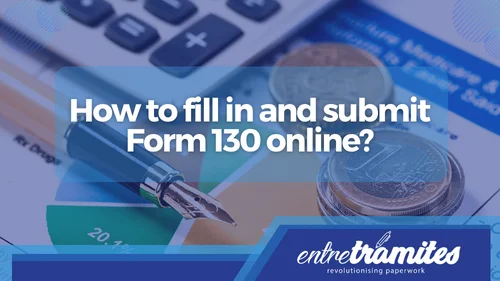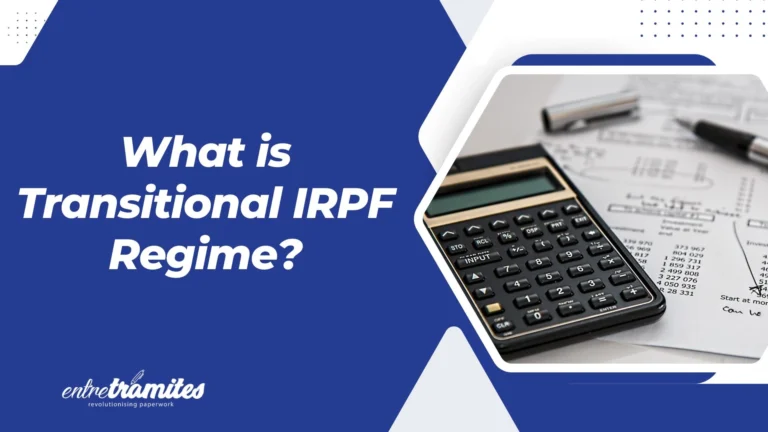We present you how to fill out and present Form 130. You will have this quarterly tax return ready to pay 20% advance payments on account of your income tax return.
What is Form 130 and what is it for?
Form 130 is a document that self-employed workers who are in normal or simplified direct estimation have the obligation to submit to the Tax Agency on a quarterly basis.
It is the document that the self-employed use to present the fractional settlement of personal income tax payments (IRPF) to the Tax Agency.
Form 130 is presented to the Tax Agency 4 times a year:
- First quarter: From April 1 to 20
- Second quarter: From July 1 to 20
- Third quarter: From October 1 to 20
- Fourth quarter: From January 1 to January 30
The personal income tax of the self-employed (IRPF)
In relation to the IRPF and the normal or simplified direct estimation regimes to which form 130 is applied, it is convenient to remember some points:
- The IRPF or Personal Income Tax is a progressive and direct personal tax that is applied to the natural income for one year of any Spanish resident.
- The simplified direct estimation is the most common personal income tax regime among the self-employed since it is applied to certain economic activities whose net turnover, for all the activities carried out by the taxpayer, does not exceed 600,000 euros in the immediate year, unless the taxpayer withdraws their application. And although we would love it not to be the case, there are few self-employed workers who have a turnover of more than 600,000 euros per year.
- The normal direct estimation. This type of estimation applies to those entrepreneurs or professionals who are not covered by the simplified estimation and provided that the turnover from the activities carried out in the previous year has exceeded 600,000 euros.
Who must present Form 130?
A significant number of the self-employed have to present form 130:
- Entrepreneurs registered in qualified business activity (IAE headings), as long as they are not in the module system, in which case they must present Form 131.
- The self-employed who carry out a professional activity, unless at least 70% of their income from the professional activity had been withheld or deposited on account in the previous year. In other words, they are exempt from Form 130 if they have invoiced with withholdings more than 70% of their turnover to companies, self-employed workers and legal entities based in Spain.
- Those who participate in a community of properties in terms of the income that corresponds to them, depending on the percentage of participation in the organization.
How is Form 130 filled out?
You can present this model electronically. It must be completed on the Tax Agency website, following the following steps:
- Declarant: Include your NIF (tax identification number), name and surname as the declarant that you are.
- Accrual: Indicates the fiscal year (year) to which the statement corresponds and the quarterly period according to the abbreviations 1Q, 2Q, 3Q or 4Q for each of the four quarters: 1st, 2nd, 3rd and 4th.
- Settlement: This is where you declare the tax you have to pay.
It consists of three subsections:
Section I is where the majority of self-employed people indicate their income and expenses for the quarter. But if you dedicate yourself to an agricultural, livestock, forestry or fishing activity, you must fill out section II instead. The data that you have to fill in includes from January 1 to the last day of the quarter that you are declaring. In other words, in the declarations for the second, third and fourth quarters you must accumulate the income and expense data from the previous quarters. The boxes corresponding to sections I and II of model 130 are briefly defined below:
- Box [01]: the income you have had throughout the year.
- Box [02]: the same, but with the expenses.
- Box [03]: the difference between the income box [01] and the expenses box [02]. Box 3 therefore shows the net income, which is nothing more than the difference between income from the set of activities carried out (box 01) and tax-deductible expenses (box 02).
- Box [04]: 20% of the amount in box [03] as long as this is positive. If it is negative, put a zero.
- Box [05]: you must include the sum of the amounts that appear in boxes [07] and [16] of Form 130 that you have previously submitted throughout the year. That is, if you are filling out the declaration for the third quarter of 2021, you will have to consult the declarations for the first and second quarters of the same year. Add the amounts of all boxes [07] and all boxes [16]. Next, from the result of the first you subtract the result of the second. Whatever it gives you, you put it in a box [05].
- Box [06]: the sum of all deductions that you have applied to your invoices since the first day of the year.
- Box [07]: subtract the amounts from boxes [05] and [06] from box [04]. If the result is negative, put the negative sign (-) in front of the figure.
You should only fill out section II if you are engaged in agricultural, livestock, forestry or fishing activities, filling in the boxes as follows:
- Box [08]: the income you have had from this type of activity throughout the year, including aid and subsidies for the activity, but not those from investments or compensation.
- Box [09]: 2% of the amount in box [08] to calculate the performance. Expenses are not taken into account.
- Box [10]: the sum of all withholdings that you have applied to your invoices for these activities since the first day of the year.
- Box [11]: subtract the amount from boxes [10] from the box [09]. If the result is negative, put the negative sign (-) in front of the figure.
Section III is dedicated to the final result of what you have to pay (total settlement). You must follow the following steps:
- Box [12]: it is the result of the sum of boxes [07] and [11]. If it’s negative, write a zero.
- Box [13]*: this is the most complicated box, as it is not filled in with the same automaticity as the previous ones. When the amount of the net income from your economic activities obtained in the year prior to that corresponding to the quarter in which the self-assessment is carried out has been equal to or less than 12,000 euros, the following amount will be entered in this box based on the amount of the stated income:
| Total net amount of net income from the previous year (euros) | Amount of the reduction (euros) |
|---|---|
| Equal or less than 9,000 | 100 |
| Between 9,000.01 and 10,000 | 75 |
| Between 10,000.01 and 11,000 | 50 |
| Between 11,000.01 and 12,000 | 25 |
- Box [14]: subtract box [12] minus box [13]. If it is negative, remember to put the “-” sign.
- Box [15]: here you must enter the negative values of the statements from previous quarters, always within the same year. If the results in boxes [19] were negative (your expenses were higher than your income), indicate it here. It is important that in this box the amount is not higher than that in the box [14].
- Box [16]: this box only affects you if the result of the box [14] has been positive and if you are paying a loan for the purchase or rehabilitation of your primary home. Here you can deduct those expenses. You can deduct 2% of the amount in box [03] or box [08] (depending on the type of activity you carry out), with a limit of 660.14 euros. Keep in mind that the amount in this box cannot be higher than the positive difference between boxes [14] and [15].
- Box [17]: difference between boxes [14] and [15].
- Box [18]: you only have to fill it out if you present a complementary declaration for the same concept, year and period. Enters the result to be paid from the returns previously filed for the same fiscal year and period. If none of the previous returns resulted in the amount to be paid, put a zero in the box [18].
- Box [19]: the result of subtracting box [17] minus [18]. This will be the result of your declaration. If the amount entered in box 19 is negative and it is a self-assessment corresponding to any of the 1st, 2nd or 3rd quarters, mark in the space reserved for this purpose within the section “To deduct”. This negative amount in box 19 may be deducted in any of the following instalment payments of the same year whose positive amount allows it. But if the amount indicated in box 19 is negative and we are facing a self-assessment corresponding to the 4th quarter, it will not complete this section, but the “Negative” section instead.
If the result is positive, this is the amount that you must pay to the AEAT for personal income tax. A negative result is not synonymous with income or a refund of the amount by the Tax Agency. Check the box that appears at the end of Form 130, where it says Type of declaration – Negative.
*How to fill in box 13 of form 130 IRPF (Personal Income Tax Form)?
The interesting thing about all this is identifying the tax base that will tell us how much we can deduct. To do this, just take as a reference the amount included in box [3] (income minus expenses) and extrapolate it to the whole year. If you like, let’s look at an example. Imagine that in box 3 there are 10,000 euros and that we are in the 2nd quarter, that is, we have been in business for 6 months. To obtain what would correspond to the whole year, you only have to make a rule of three of the following order: 10,000 is 6 months and 20,000 is 12. This results from dividing 10,000 by 6, and we have what would correspond to a single month (1666.66). We multiply this by 12 and obtain what would correspond to the entire year; that is, 20,000.
10,000—–>6 months; 10,000/6= 1,666.66 1,666.66——>1 month; 1,666.66×12= 20,000 20,000—–> 12 months.
So the tax base is 20,000. Taking this into account, there would be no possibility of deduction from the tax base because there are certain limits defined as follows:
- If the resulting tax base is equal to or less than 8,000 euros, you can deduct 100 euros in each quarterly form 130.
- If it is between 8,001 and 12,000 euros, the amount of the deduction will be determined by the following operation: 400 – (tax base – 8,000) x 0.1 euros per year.
- If it is greater than 12,000 euros, you will not be able to deduct anything.
Let’s now see an example with a tax base that allows deductions. If the tax base was €4,000 then you could deduct €400 according to the first rule. If the tax base were €10,000, then you could deduct the result of the following formula: 400 – (10,000 – 8,000) x 0.1 = 400 – 2,000 x 0.1 = 400 – 200 = 200. Now, you have to keep in mind that this would be the annual deduction limit, so knowing that the return is quarterly, you would have to divide by 4 to find out the amount to deduct per quarter. In the first case, it would be €100 and in the second €50. And it is these last two amounts, from each respective example, that you must write in the box [13].
Form 130 in .pdf to fill in
The Tax Agency provides a Form 130 PDF format to fill out the document and create the quarterly declaration. To download Form 130 in .pdf you simply have to go to the form here.
How to present Form 130?
Since 2015, there have been only two forms of presentation of Form 130.
- Electronic presentation through the Tax Agency website. Without a doubt, the most recommended system. You can do it yourself or it is better to have our support, it is always good to leave tax issues in the hands of specialists.
- Paper presentation of the model generated by the application that the Tax Agency itself makes available on its website and that allows the creation of Form 130 in PDF format and its printing to present it at the bank or in the Tax Agency offices themselves.
As you can see, filling in Form 130 is easier than it seems, but doing it on your own will consume valuable time that you could dedicate to your company. At Entre Trámites we offer various services of management, advice, and support in bureaucratic procedures for self-employed, SMEs, and other types of companies.
Contact us! Through our contact form, you can leave your details for us to call you, schedule a free consultation, or simply text our WhatsApp.





